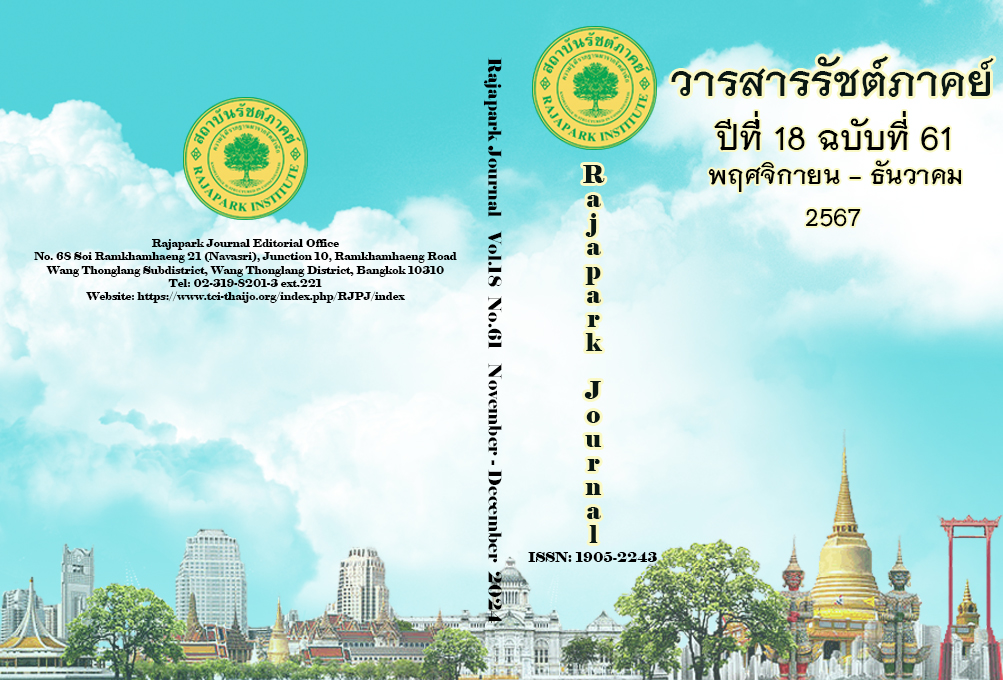The Development of Airport Identity of Chiang Mai International Airport Through the Creation of Airport Sense of Place
Main Article Content
Abstract
This research aimed to 1) study the successful and challenging factors of airports of Thailand Public Company Limited in developing airport identity of Chiang Mai International Airport, Thailand; 2) identify the perception of airport stakeholders towards the implementation of airport identity of Chiang Mai International Airport, Thailand; and 3) propose a framework in planning and development of airport identity of Airports of Thailand Public Company Limited. The sample was 31 interviewees. They were selected by purposive sampling and snowball sampling. The instrument for collecting data was an in-depth interview. Analysis of data by Content Analysis. The research results were found as follows; 1) Airports of Thailand Public Company Limited had a Thailand Gateway Policy to develop the airport identity of six international airports; 2) Airport stakeholders had a perceived value of the airport sense of place; and 3) propose a development framework to create a successful airport identity consisting of airport strategy, airport design, airport attributes, airport revenue management, and airport community engagement.
Article Details

This work is licensed under a Creative Commons Attribution-NonCommercial-NoDerivatives 4.0 International License.
Views and opinions appearing in the Journal it is the responsibility of the author of the article, and does not constitute the view and responsibility of the editorial team.
References
Airports of Thailand. (2021). New normal digital transformation in the aviation industry: Annual Report 2021. https://investor.airportthai.co.th/misc/AR/20220121-aot-ar-2021-th.PDF
Airports of Thailand. (2022). Airports of Thailand Annual Report 2022. https://investor.airportthai.co.th/ar.html
Bitner, M. J. (1992). Servicescapes: The Impact of Physical Surroundings on Customers and Employees. Journal of Marketing, 56(2), 57-71. DOI:10.2307/1252042
Bogicevic, V. (2014). The effect of airport servicescape features on traveler anxiety and enjoyment[Master's thesis, University of South Florida]. https://digitalcommons.usf.edu/etd/4987
Dehghanloo, S., & Akhoondnejad, A. (2017). Visitor motivation, satisfaction and loyalty: The case of international festival of Iran’s tribes’ culture. In Conference: 1st National Conference on Tourism: Managing Opportunities and Attractions, Yazd, Iran.
Elo, S., & Kyngäs, H. (2008). The qualitative content analysis process. Journal of Advanced Nursing, 62(1), 107-115. https://doi.org/10.1111/j.1365-2648.2007.04569.x
Ministry of Tourism & Sports. (2022). Domestic tourism statistics Q1-Q4 (Classify by region and province). https://www.mots.go.th/news/category/766
Hackett, P., & Foxall, G. (1997). Consumers’ evaluations of an international airport: Afacet theoretical approach. The International Review of Retail, Distribution and Consumer Research, 7(4), 333-349. DOI:10.1080/095939697342923
Hay, R. (1998). Sense of place in developmental context. Journal of Environmental Psychology, 18(1), 5-29. https://doi.org/10.1006/jevp.1997.0060
IATA. (2016). Airport development reference manual. https://www.iata.org/publications/Documents/adrm10-toc-20161021.pdf
Jiang, H., & Zhang, Y. (2016). An assessment of passenger experience at Melbourne Airport. Journal of Air Transport Management, 54, 88-92. DOI:10.1016/j.jairtraman.2016.04.002
Kanok-Nukulchai, W., & Vimuktayon, V. (2009). Suvarnabhumi Airport, Thailand. Structural Engineering International, 19(1), 6-11.
https://doi.org/10.2749/101686609787398164
Kim, H., Oh, C.-O., Lee, S., & Lee, S. (2018). Assessing the economic values of world heritage sites and the effects of perceived authenticity on their values. International Journal of Tourism Research, 20(4), 126-136. DOI:10.1002/jtr.2169
Milman, A., & Pizam, A. (1995). The role of awareness and familiarity with a destination: The central Florida case. Journal of Travel Research, 33(3), 21-27. DOI:10.1177/004728759503300304
Moon, H.G., Yoon, H.J., & Han, H. (2015). Role of airport physical environments in the satisfaction generation process: Mediating the impact of traveller emotion. Asia Pacific Journal of Tourism Research, 21(2), 1-19. DOI:10.1080/10941665.2015.1048260
Noobanjong, K. (2009). The passenger terminal at Suvarnabhumi international airport and Thai identity in the midst of globalization era. Journal of Architectural/Planning Research and Studies (JARS), 6(3), 23-44. https://so02.tci-thaijo.org/index.php/jars/article/view/168715
Raturi, R. (2018). Adapting deep features for scene recognition utilizing places database. In Conference: 2018 Second International Conference on Inventive Communication and Computational Technologies (ICICCT), 20-21 April 2018. DOI:10.1109/ICICCT.2018.8473136
Renard, R. D. (1999). The image of Chiang Mai: The making of a beautiful city. Journal of the Siam Society, 87(1-2), 87-98. https://thesiamsociety.org/wp-content/uploads/1999/03 /JSS_087_0h_Renard_ImageOfChiangMai.pdf
Rowley, J., & Slack, F. (1999). The retail experience in airport departure lounges: Reaching for timelessness and placelessness. International Marketing Review, 16(4-5), 363-376. https://doi.org/10.1108/02651339910281901
Seamon, D., & Sowers, J. (2008). Place and Placelessness, Edward Relph. In: Key Texts in Human Geography. DOI:10.4135/9781446213742.n5
Sheth, J.N., Newman, B.I., & Gross, B.L. (1991). Why we buy what we buy: A theory of consumption values Author links open overlay panel. Journal of Business Research, 22(2), 159-170. https://doi.org/10.1016/0148-2963(91)90050-8
Smith, S. (2015). A sense of place: Place, culture and tourism. Tourism Recreation Research, 40(2), 1-14. DOI:10.1080/02508281.2015.1049814
Soonsan, N. (2018). An investigation into the relationship between country image and destination image in tourism promotion: The case of Thailand. NIDA Development Journal, 58(2), 123-147.
van Oel, C. J., & van den Berkhof, F. W. (2013). Consumer preferences in the design of airport passenger areas. Journal of Environmental Psychology, 36, 280-290. https://doi.org/10.1016/j.jenvp.2013.08.005
Wang, N. (1999) Rethinking authenticity in tourism experience. Annals of Tourism Research, 26, 349-370. https://doi.org/10.1016/S0160-7383(98)00103-0
Yerimou, P., & Panigyrakis, G. (2020). The role of atmospherics as an antecedent of airport and country image: A cross-cultural study. In Conference: Global Marketing Conference (GMC), November 2020. Seoul, Korea.
Yerimou, P., & Themistocleous, C. (2024). (Re)Defining airport experience: A new framework proposition. In Book: Marketing Solutions to the Challenges of a VUCA Environment (pp.69-84). DOI:10.1007/978-3-031-58429-9_5
Zhang, H., Fu, X., Cai, L., & Lu, L. (2014). Destination image and tourist loyalty: A meta-analysis. Tourism Management, 40(4), 213-223. DOI:10.1016/j.tourman.2013.06.006


